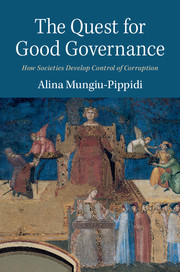Book contents
- Frontmatter
- Colophon
- Contents
- List of figures
- List of tables
- List of abbreviations
- Acknowledgments
- 1 Understanding control of corruption
- 2 Diagnosis and measurement
- 3 The road to Denmark: historical paths to corruption control
- 4 Structure and agency: determining control of corruption
- 5 Understanding contemporary achievers
- 6 Domestic collective action capacity
- 7 International agency and its anticorruption impact
- 8 From critical mess to critical mass: some tentative policy conclusions
- Appendix 1 Explaining bribery
- Appendix 2 List of variables and sources
- Appendix 3 Brief description of databases and surveys used
- Appendix 4 Impact of anticorruption interventions on control of corruption: bivariate regressions
- Appendix 5 HDI differentials from Figure 4.1
- Appendix 6 Classification of countries by governance orders
- References
- Index
2 - Diagnosis and measurement
Published online by Cambridge University Press: 05 September 2015
- Frontmatter
- Colophon
- Contents
- List of figures
- List of tables
- List of abbreviations
- Acknowledgments
- 1 Understanding control of corruption
- 2 Diagnosis and measurement
- 3 The road to Denmark: historical paths to corruption control
- 4 Structure and agency: determining control of corruption
- 5 Understanding contemporary achievers
- 6 Domestic collective action capacity
- 7 International agency and its anticorruption impact
- 8 From critical mess to critical mass: some tentative policy conclusions
- Appendix 1 Explaining bribery
- Appendix 2 List of variables and sources
- Appendix 3 Brief description of databases and surveys used
- Appendix 4 Impact of anticorruption interventions on control of corruption: bivariate regressions
- Appendix 5 HDI differentials from Figure 4.1
- Appendix 6 Classification of countries by governance orders
- References
- Index
Summary
Operationalizing governance contexts
The issue of corruption measurement is as contentious as – and related to – the issue of defining corruption. How can an insidious phenomenon, where academics only agree that the boundaries inherent to any definition are culturally and historically specific, be measured in a valid, precise, and reliable way so to allow comparisons across space and time, leading to the elaboration of a comprehensive theory? While pressure from the international development community led to the creation of a first generation of indices such as Transparency International's Corruption Perceptions Index, the gains in terms of measurement are weighed down by limitations, in particular the bias toward the international business community, leading to a reductionist view of corruption mostly as bribery (Johnston 2000). Since this first generation, other measures more inclusive of other aspects of corruption, including favoritism, have been developed, but the major challenges of indicators to be comparable across countries and sensitive to change and policy intervention persist.
Many critics of the first-generation governance indicators argue that the absence of a good theory is what renders governance so hard to measure (Rothstein and Teorell 2012). But if the theory fails, it might be because terms such as governance, good governance, and quality of government are by nature too broad and ambitious, and those who interpret them more narrowly can measure them only at the risk of measuring something different than others understand. My particular aim is to measure the construct of “control of corruption” as described in Chapter 1. Is it not measurable if we focus simply on the continuum between ethical universalism and particularism and ascertain the transactional norm in a given country? Would this also not result in a taxonomy of governance less normative and confusing than discussions of “good governance,” which can be used to justify both authoritarian and democratically elected governments? Some authors express skepticism over measurements of government based on procedures versus outcomes, agreeing that “procedures, however defined, may not actually correlate with the positive outcomes expected from governments” (Fukuyama 2013; Rotberg 2014.
- Type
- Chapter
- Information
- The Quest for Good GovernanceHow Societies Develop Control of Corruption, pp. 27 - 56Publisher: Cambridge University PressPrint publication year: 2015



